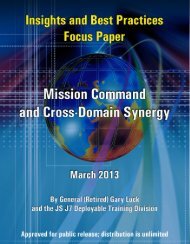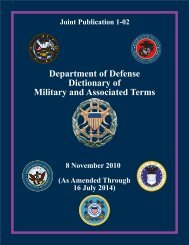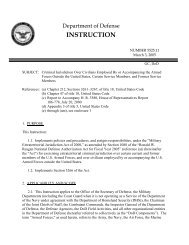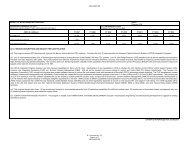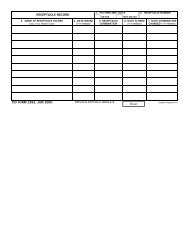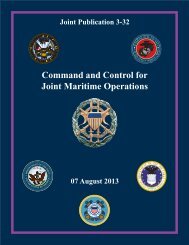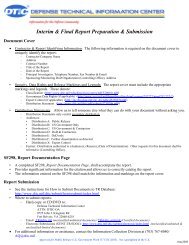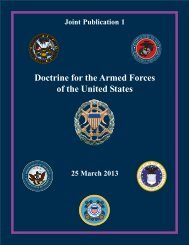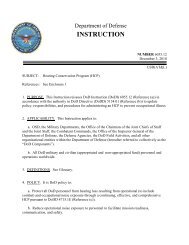JP 3-16, Multinational Operations - Defense Technical Information ...
JP 3-16, Multinational Operations - Defense Technical Information ...
JP 3-16, Multinational Operations - Defense Technical Information ...
Create successful ePaper yourself
Turn your PDF publications into a flip-book with our unique Google optimized e-Paper software.
Chapter III<br />
32. Transitions<br />
a. Transitions are critical to multinational operations. In general, transitions fall into<br />
three categories: the orderly turnover of a plan or order as it is passed to those tasked with<br />
execution of the operation (i.e., future operations to current operations); transition between<br />
the various phases of an operation or campaign (such as phase II: seize the initiative to phase<br />
III: dominate); and the transition of authority for the effort from one organization to another<br />
(i.e., JTF to MNF or MNF to IGO/HN).<br />
b. The transition of plans to execution provides information, direction, and guidance<br />
relative to the plan or order that will help to facilitate SA. Additionally, it provides an<br />
understanding of the rationale for key decisions necessary to ensure there is a coherent shift<br />
from planning to execution. These factors coupled together are intended to maintain the<br />
intent of the CONOPS, promote unity of effort, and generate tempo. Successful transition<br />
ensures that those charged with executing an order have a full understanding of the plan.<br />
Regardless of the level of command, such a transition ensures that those who execute the<br />
order understand the commander’s intent and CONOPS. Transition may be internal or<br />
external in the form of briefs or drills. Internally, transition occurs between future plans and<br />
future/current operations. Externally, transition occurs between the commander and<br />
subordinate commands.<br />
For more information on plan transitions, see <strong>JP</strong> 5-0, Joint Operation Planning.<br />
c. Phases. A phase can be characterized by the focus that is placed on it. Phases are<br />
distinct in time, space, and/or purpose from one another, but must be planned in support of<br />
each other and should represent a natural progression and subdivision of the campaign or<br />
operation (see Figure III-10). Each phase should have a set of starting conditions (that define<br />
the start of the phase) and ending conditions (that define the end of the phase). The ending<br />
conditions of one phase are the starting conditions for the next phase.<br />
(1) Working within the phasing construct, the actual phases used will vary<br />
(compressed, expanded, or omitted entirely) with the joint campaign or operation and be<br />
determined by the MNFC. During planning, the MNFC establishes conditions, objectives, or<br />
events for transitioning from one phase to another and plans sequels and branches for<br />
potential contingencies. Phases are designed to be conducted sequentially, but some<br />
activities from a phase may begin in a previous phase and continue into subsequent phases.<br />
The MNFC adjusts the phases to exploit opportunities presented by the adversary or<br />
operational situation or to react to unforeseen conditions. A joint campaign or operation may<br />
be conducted in multiple phases simultaneously if the OA has widely varying conditions.<br />
For instance, the commander may transition to the stabilize phase in some areas while<br />
remaining in the dominate phase in those areas where the enemy has not yet capitulated.<br />
Occasionally operations may revert to a previous phase in an area where a resurgent or new<br />
enemy re-engages friendly forces.<br />
III-50 <strong>JP</strong> 3-<strong>16</strong>



